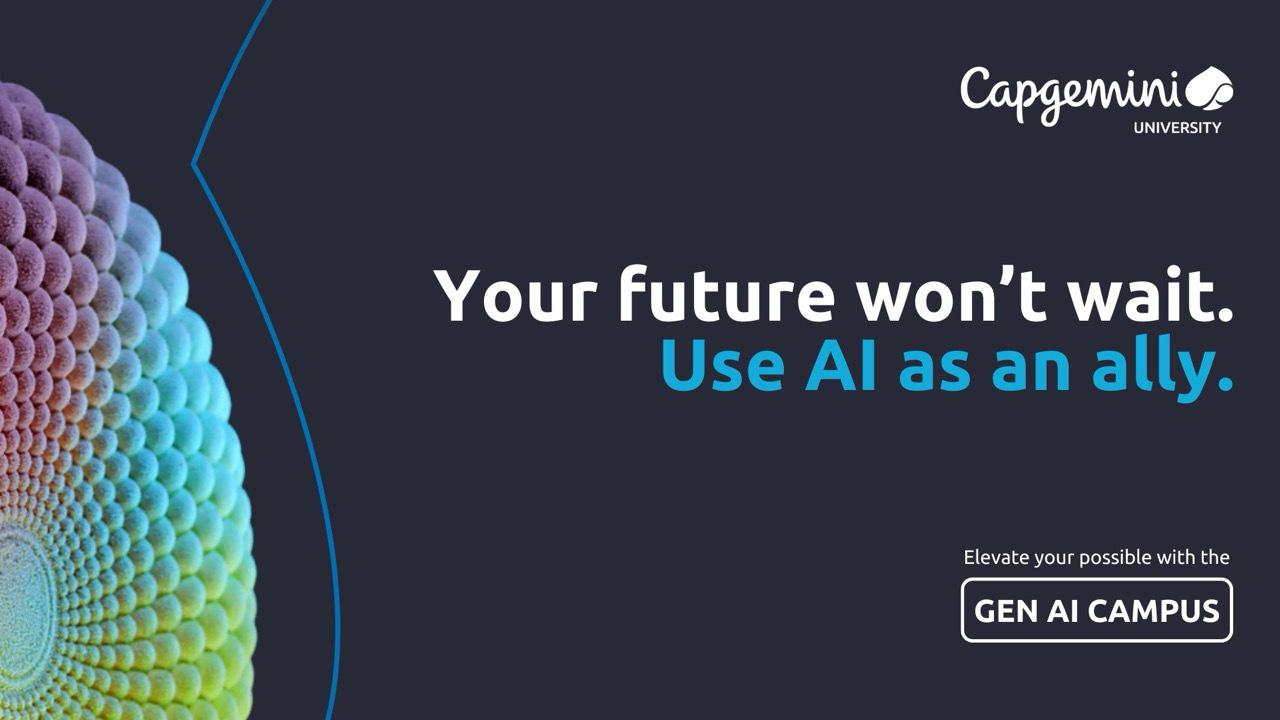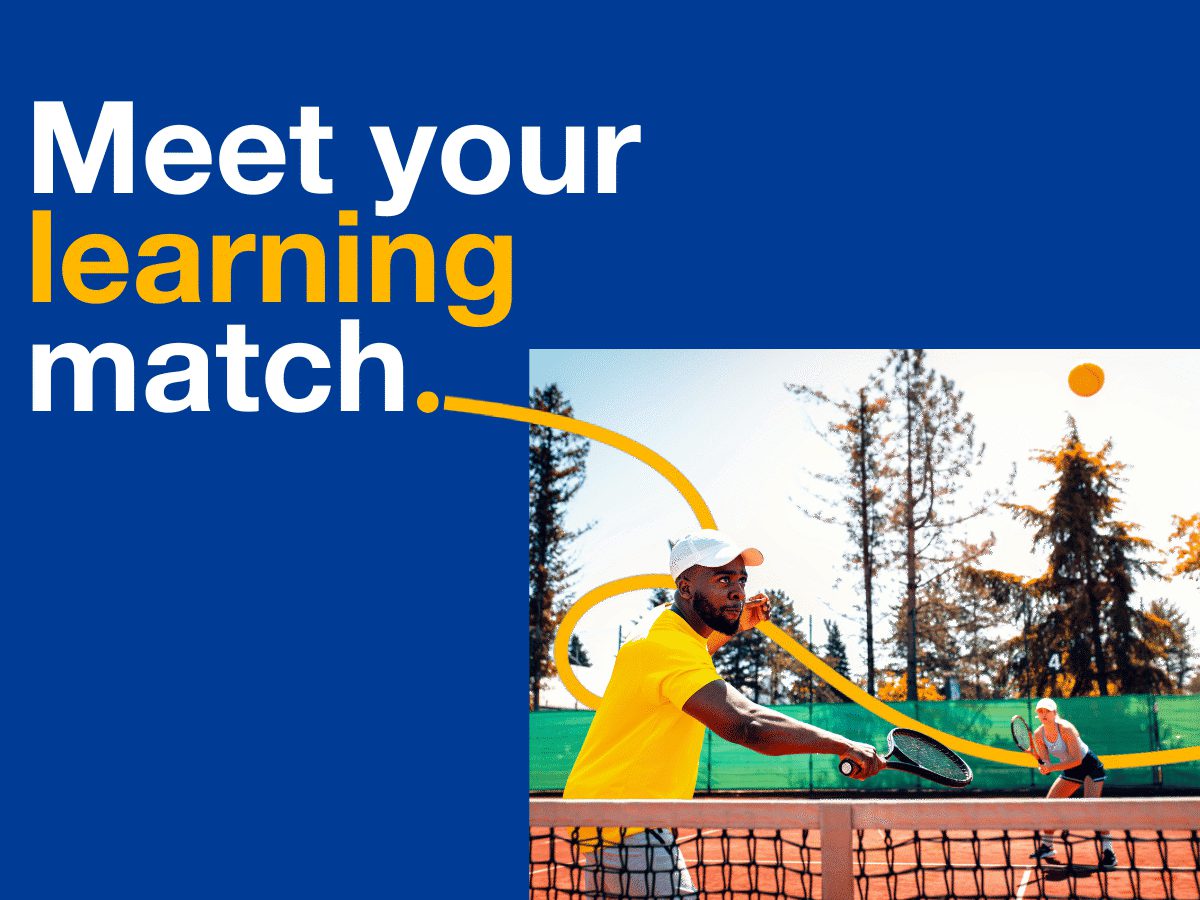want some cookies?
We use cookies to make your browsing experience amazing.

Okay, we talk a lot about learning campaigns around here. But often when I speak to learning folk, you tell me the same thing time and time again: you struggle to come up with ideas. So in this blog, I’m going to highlight some super successful features of learning campaigns I’ve seen (or created 👀) and tell you why they worked so well. And hopefully they’ll inspire your next campaign — or you know, you can just steal my ideas. Whatever works for you!
1. NAIL THE TAGLINE (CAPGEMINI UNIVERSITY)
The Generative AI campaign we created for Capgemini University was closely connected to their external Generative AI messaging. Which meant that when it came to the visuals of this campaign, we were very restricted. It’s a challenge L&D knows all too well — instruction about branding and design comes from marketing or internal comms, and there’s very little we can do to influence it.
But that doesn’t mean it’s time to chuck in the towel and give up. No, it means you have to put your copy to work even more. When creating the campaign concepts we sat down and really dug into our audience. What did they care about? How did they feel about AI? How was it going to impact their role? And then we flexed our copywriting muscles and leveraged rhyming to make the tagline and our headings sticky.
Our tagline was: Your future won’t wait. Use AI as an ally.

And an example heading: Detecting litter from the sky. All in a day’s work, for Gen AI.
Despite using visuals our audience had seen numerous times before, this campaign worked phenomenally well (we’re talking 82% of their 340,000 strong workforce engaging). And truthfully, that’s down to clever copy work.
Oh, and did we mention this campaign is award winning? 👀
2. USE INFLUENCERS TO SELL LEARNING (DECHRA ACADEMY)
In my opinion, influencer marketing is one of the most overlooked tactics in internal comms. And this frustrates me so much. Influencer marketing is a huge industry of its own right now, and for good reason too: People believe people more than they believe a brand. And when it comes to internal marketing, that’s an even stronger emotion.
Your employees (or learners, if you really want to call them that!) trust their colleagues more than they trust you. If you – the L&D professional – tell them they should really take this training course, they’ll likely dismiss your claim. Because simply put: of course you think they should take it, it’s your job to make them want to take it! But if their colleague, with no vested interest in learning, recommends a programme — that’s got more weight. So that’s why you have to utilise influencers in your marketing for learning® efforts.
And that’s exactly what we did with Dechra Academy. Instead of telling veterinary professionals how they should prioritise their CPD and use Dechra Academy to do it — we got their peers to tell them what they did, and why Dechra Academy was their go-to resource.
Again, this campaign worked incredibly well, boosting enrolments by 115%, completions by 149% and bagging us another award for the trophy cabinet!
3. MIMICK TIKTOK, NOT CORPORATE COMMS (GLOBAL BANK)
Ok, we have to be a bit secretive with this one, as a pesky NDA stops us talking about the company. However, we can tell you about a tactic that worked wonders: mimicking the external world of advertising, particularly TikTok.
Although as a global bank, this organisation typically erred on the side of corporate, their employees were looking for more. Through thorough research, we uncovered that their audience used TikTok more than LinkedIn, and cared a lot less about career progression than one might assume.
So what did we do? We tore up the corporate rule book and created fun, engaging, bite-sized videos to get people hooked on learning. This mimicked the content employees engaged with outside the workplace — and stopped them in their tracks and made them stop scrolling and actually pay attention to learning at work. See it for yourself:

4. EXPAND YOUR THEME (INTERNATIONAL TRAVEL COMPANY)
One of my biggest pet peeves about most learning communications is the boring stock imagery everybody seems to use. Employees laughing at computers… Someone typing on a keyboard… A team looking happier than my husband did on our wedding day… It’s just all so trite and unconvincing.
And this global travel company had fallen into that trap for many years, until we came along and put a stop to it. Instead of corporate stock imagery that belongs in the 90s, we brought a fresh new look to learning communications. It stayed on brand, connected with the content, but captured the audience's attention. Take this post as an example: The tagline was: Meet your match. So they’re playing a tennis match… get it? We’re expanding the theme and grabbing attention. And there’s not a single computer screen in sight!

5. LEAN INTO YOUR BRAND, WITHOUT BEING CHEESY (STARBUCKS)
Okay, this idea comes back to powerful copy again. But this time, we’re playing on the field or industry the organisation works for. Here we’re looking at Starbucks — who quite simply need no introduction to anybody on the planet. Millions of people head to the shop daily to get their fill of coffee… so why wouldn’t their employees get their fill of learning?

The truth is, when it comes to puns, your taglines can quite easily become cheesy. But this one doesn’t. Because it’s subtle, it’s casual and it quite simply nods to the Starbucks audience. So if you’re going to get punny, and play on your forte, heed this warning: there’s a fine line between playful puns and out-and-out tackiness!
6. GAMIFY THE RIGHT THING (LR ACADEMY)
I’m not one to usually promote competitions or incentives in L&D. And that’s because more often than not, they’re used to make people do the learning, which typically leads L&D teams into a sticky situation where employees won’t do learning, unless they’re incentivised in some way.
However, that does not mean I do not think competitions work in marketing for learning. In fact, in the learning campaign we created for LR Academy, it worked incredibly well. And that’s because we didn’t incentivise the learning itself, but rather the sharing and recommendation of learning content to colleagues.
The competition was simple: The three people who recommended the most courses (that they themselves had completed) throughout the competition period won a prize.
The caveat of having to take the learning themselves meant that employees couldn’t become spammy — recommending irrelevant content to colleagues across the organisation. Instead it fostered a culture of sharing, collaboration and human connection in the workplace, something employees told us they missed in a post-Covid world!
7. PERSONALISE, PERSONALISE, PERSONALISE! (GLOBAL GOVERNMENT ORGANISATION)
Ok, this is another secretive client, but as a global government organisation, that isn’t surprising, is it? But for our last bit of inspo of this blog, we’re sharing one of the simplest learning campaigns tactics of them all: personalisation.
If you’re running a marketing campaign for your L&D function, and you’re sending out one generic message to your entire audience — you’re doing yourself a disservice. Due to the nature of this government institution, they were incredibly limited on the channels they could use to hook their audience into learning, so relied heavily on email. But blanket emails were not hitting the mark. They had low open and click through rates, and even lower engagement rates with their learning.
That was until we rocked up and showed them the power of learner personas.
By creating and using learner personas throughout their email marketing, we managed to boost the active user rate on their LMS from 6% to 24% in just one month. 😱 And all we did was listen to their audience, and personalised emails that were already being sent, making sure we answered the WIIFM and got the audience hooked.
LEARNING CAMPAIGNS DON’T HAVE TO BE CRAZY TO WORK
The truth is, most of these ideas are not beyond the realms of possibility for most L&D teams. And that’s where a lot of teams go wrong when devising learning campaigns. They overthink it, they think they need to get Super Bowl ads a run for their money. And in all honesty, we don’t. We simply have to think outside the echo-chamber of L&D, put our audience first, and flex our marketing muscles. No million-dollar ad budget. No Hollywood script. Just smart campaigns, built by people who get it — and made for people who don’t care about learning... yet.










